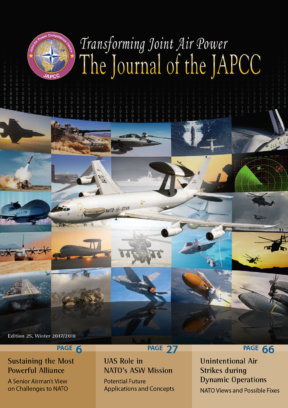Introduction
In 1999, the European Commission (EC) launched the ‘Single European Sky’ (SES) initiative to solve the European Air Traffic Management (ATM) system’s inability to deal with increasing congestion of the fragmented European airspace. Bolstered by subsequent European Union (EU) legislative packages, SES aims at a pan-European airspace independent of national borders as well as tackling future air transport demands regarding safety, capacity, efficiency, and environmental protection. SES ATM Research (SESAR) is the supporting programme developing future ATM capabilities and technology necessary for safe, efficient, and effective airspace utilization.1
To safeguard the ability of combined packages of military forces to operate and train across national airspace boundaries in Europe, NATO Air Power must rely on coordinated civil-military ATM for airspace organization, allocation, mission planning, execution, and control. The military has therefore been involved in SES and SESAR since their inception, as a user, service provider, and in some cases even as a regulator. On the civil aviation side, the EU has gained ATM rulemaking authority across Europe. However, military matters often remain a national responsibility, and European ATM solutions have been only adopted based on the nature of national requirements and the peculiarities of airspace constraints. This has led to fragmented organizations, regulations, service provision, and civil-military coordination arrangements, with consequential shortfalls in the facilitation of military cross-border air operations.
EUROCONTROL is an intergovernmental European civil-military organization which supports the EC, the European Aviation Safety Agency (EASA), and National Supervisory Authorities in their regulatory activities. EUROCONTROL is committed with its partners to deliver the ATM performance required to build SES, which will also feature projects and activities to address specific military needs.
European Operational Air Traffic Rules (EUROAT)
As providers and consumers of Air Traffic Services (ATS), the military uses the same Instrument Flying Rules (IFR) as does General Air Traffic (GAT). In addition, most governments have developed national rules and services to meet specific IFR requirements for their mostly military ‘Operational Air Traffic’ (OAT).2 To appropriately facilitate OAT and its interface with GAT in the SES environment, EUROCONTROL published in 2013 a set of ‘Specifications for harmonized Rules for OAT under IFR inside controlled airspace of the European Civil Aviation Conference (ECAC) area’.3 The agreement, referred to as EUROAT, is the first military deliverable of the European ATM Master Plan and intended to become a single reference for OAT in a ‘single sky’ ranging across all 44 ECAC member countries.4 The aim is to provide a regulatory framework for OAT-IFR in controlled airspace on a European scale and to appropriately facilitate the interface between OAT and GAT, while minimizing the impact on military operational procedures or aerial tactics as much as possible. This is accomplished by adhering to three principles:5
- Whenever possible, the same definitions, rules and procedures specified by the International Civil Aviation Organization (ICAO) and the Standardized European Rules of the Air (SERA) for GAT flights shall be applied.
- Required rules for OAT, in addition to, or deviating from ICAO/SERA provisions are detailed within the EUROAT.
- Where operational requirements of a flight are incompatible with either of the above, these requirements should be met by using an Airspace Reservation (ARES) of appropriate type and dimension, or methods that are considered sufficiently safe and which have been approved by the appropriate national authority.
National implementation of the specified rules and procedures will underpin OAT-IFR harmonization and standardization in the controlled airspace of all nations that have chosen to implement EUROAT. Ideally, EUROAT should apply to all aircraft flying under OAT-IFR, but national constraints may result in deviations from the specifications within their sovereign airspace. In any case, military and other State aircraft6 will still require a valid diplomatic clearance when crossing national borders.
OAT Transit Service – Providing Short-Term Solutions
As long as the shortfall of harmonized OAT-IFR services for transit across Europe persists, military cross-border traffic will continue to use GAT IFR rules not satisfying military OAT specific needs like being provided in EUROAT principles. However, those GAT rules and services were not designed to address specific requirements for OAT transit in non-segregated airspace (i.e. without segregation using an ARES). Issues could be:
- Day to day management by service providers of potentially confidential trajectory data for military OAT-IFR transits.
- Military high priority missions (such as Quick Reaction Alert, Medical Evacuation, or any other type of time-critical flight mission) cannot be subject to Air Traffic Flow Management since their flight profile is not negotiable.
- Handling of military transit flights may require special procedures, skills and training. It can be in support of training packages or for executing en route Air-to-Air Refuelling (AAR) with limited aircraft manoeuvrability. The handler should be familiar with constraints and contingency procedures for Remotely Piloted Aircraft (RPA) or flights with live weapons and to be able to ensure safe separation, with minimum impact on GAT traffic.
- Military avionics and specific military Communication, Navigation and Surveillance (CNS) systems may require rule derogations, special provisions, and highly secure interfaces to civilian net-centric ATM solutions.
- In the event of operational or technical outage, the provision of ATS and CNS services needs to be transferred to the most appropriate centre or service provider.
These issues further highlight the systematic consideration of military requirements needed to integrate military cross-border operations into the European ATM network. While EUROAT provides the respective baseline, its effective implementation across the ECAC area will probably take many years. This has led to the foundation of the OAT Transit Service (OATTS) to safeguard the effectiveness of military operations by connecting national structures and arrangements with each other to facilitate short-term civil-military ATM solutions. OATTS is a combination of air navigation services and their supporting services provided either by military, civil, or civil-military Air Navigation Service Providers (ANSPs). While OATTS started as an initiative among the 17 EUROCONTROL member states who have committed so far to implementing EUROAT, it aims to develop a pan-European OATTS to ultimately implement OAT-IFR (EUROAT) on a wider ECAC scale.
OATTS implementation initially requires an agreement on its concept and on harmonized procedures. Some technical changes are also needed to share all necessary information, from the planning to the execution phase. OATTS enablers should address all types of mission needs and technical gaps. However, a realistic approach would be to target progressive implementation, starting with initial hand-over procedures (e.g. sharing of cross-border entry/exit and navigation points) as well as sharing and processing all requisite aeronautical information and trajectory data.
Improved OAT Flight Plan (iOAT FPL)
In the past, military flight plan (FPL) formats were not harmonized on a European level and information was not disseminated throughout the ATM network. This lack of awareness about military traffic intentions impacted ATM network performance, flexibility, and interoperability in particular when dealing with cross-border exercises. To solve this, OATTS created the ‘improved OAT FPL’ (iOAT FPL), an enhanced military flight planning system. Based on the ICAO 2012 FPL format and the EUROCONTROL Integrated Initial Flight Plan Processing System (IFPS), OATTS provided harmonized rules for the description of trajectory elements as a first step toward implementing the Mission Trajectory detailed concept previously developed by EUROCONTROL as the best means of accommodating military flights in the future Trajectory Based Operations (TBO) environment. TBO is one important objective of SESAR activities to overcome the deficiencies of static flight plans which have been used until present in the ATM environment for both civil and military users.
For military air operations, the iOAT FPL will constitute the initial description of the ‘Mission Trajectory’ (MT). Once delivered it would become an initial Shared Mission Trajectory (iSMT). It would then be continuously updated with more accurate and current data as mission planning progresses. In this way, the iOAT FPL allows the appropriate authorities to see the MT from planning to execution via the responsible national Wing Operation Centre (WOC). The iOAT FPL will also allow sharing ARES information and military activity intentions with the Network Manager and the relevant partners, including Area Control Centres (ACCs).
Summary
The full implementation of the OATTS would be a concrete demonstration of civil-military partnership and collaboration to support all operational requirements at minimum cost. The benefits are:
- Accommodating harmonized requirements for cross-border OAT-IFR transit.
- Service adaptation to military avionics constraints.
- Facilitating the management of unexpected events like mission abortion on the ground or in the air due to technical failure or flight weather conditions.
- Facilitating a variety of trajectory profiles, including transition from low-level Visual Flight Rule (VFR) to high-level IFR, like slow speed transit for RPA, en route AAR, long-endurance surveillance flights.
- Enhanced data consistency achieved through a harmonized FPL format and content for OAT-IFR flights in controlled European airspace.
- Full awareness of OAT-IFR flights for both military and civil ATCs through dissemination of respective iOAT FPL data to all parties concerned.
- The Network Manager and ANSP are better aware of OAT operations including the planned and allocated ARES for individual missions.
- Ensuring confidentiality by distribution to military and civil ATC centres only on a need-to-know basis.
- Provision of certified aeronautical information and more options to military planners and airspace users.
Having said this, it must be noted that practicable solutions such as the OATTS are only interim steps on a still long way to go. A main obstacle to fully workable civil-military arrangements for future European ATM is a continuous lack of common agreed military positions amongst the nations. This is partly a result of not enough understanding and support from national politico-military authorities.7
Conclusion
Constantly implementing new ATM requirements – using verified and validated collaborative mechanisms – demonstrates just how willing the military community is to strike a balance between the growing challenges in complying with very demanding SES requirements and the military’s natural commitment to its security and defence responsibilities. In fact, these two sets of obligations form the foundation on which all future integration processes should be developed in civil-military ATM cooperation and coordination.
The SES, in one way or another, will be achieved and will create both challenges and opportunities for European military forces. Awareness, proper analysis, and use of existing expertise for making informed decisions to adapt where necessary are major prerequisites underpinning NATO Air Power training and execution in European airspace.












